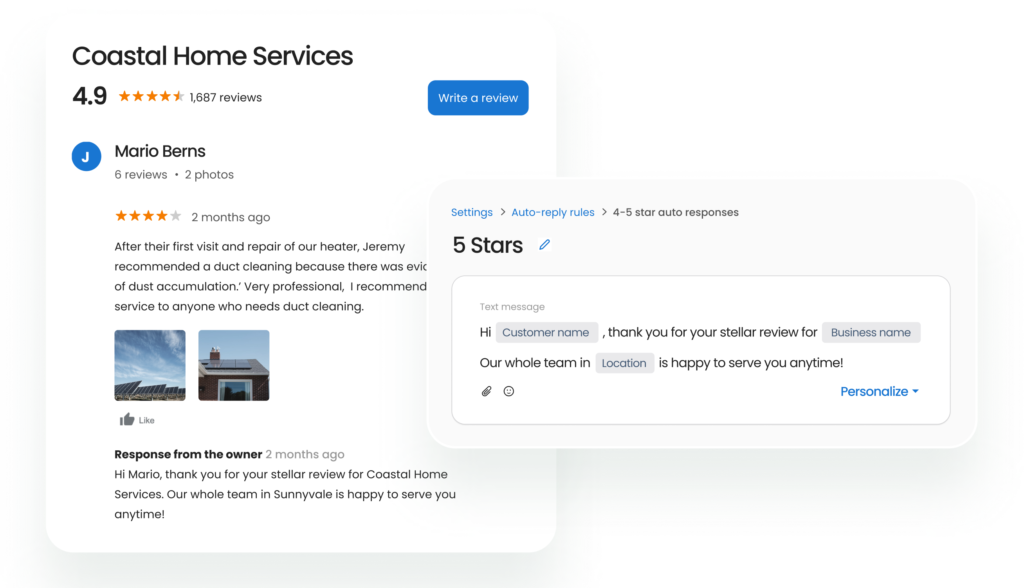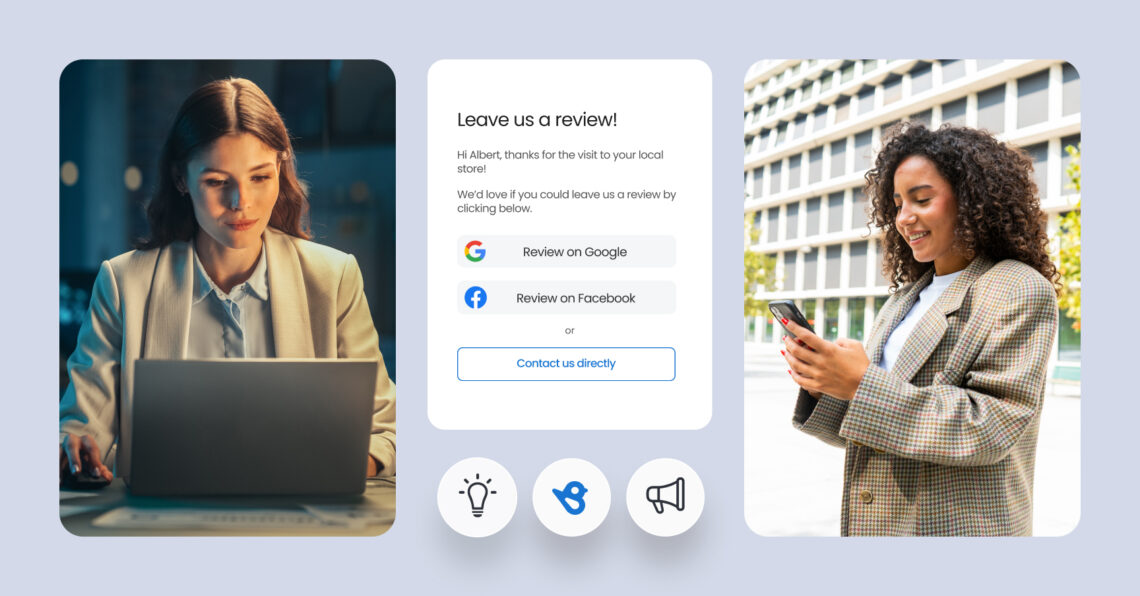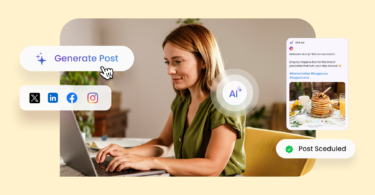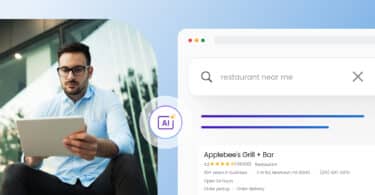Choosing the right customer engagement platform isn’t easy, not because there are fewer options, but because every platform claims to do it all.
Many platforms promise to help you “engage customers,” but most fail to improve communication, retention, or customer satisfaction. They might shine in demos, but struggle to scale across locations, connect your customer data, or support real-time interactions.
They’re either too complex, too siloed, or too focused on vanity metrics like message volume instead of what matters: customer experience, retention, and revenue.
The real challenge isn’t finding “a tool that does it all”—it’s choosing one that helps your customer-centric marketing, service, and frontline staff work together to deliver timely, consistent experiences across the entire customer journey.
In this blog, we’ll explore 11 powerful but often overlooked features to look for in a customer engagement platform — and see how businesses using Birdeye’s GenAI tools are improving CX outcomes at scale.
What most platforms won’t tell you 🤐
The real challenge isn’t managing omnichannel communication, it’s understanding customer behaviors across every touchpoint without drowning your team. A true customer engagement platform should act like an extension of your support, ops, and marketing teams — surfacing insights, automating reviews, and adapting to how customers interact with your brand.
The hard part? Finding a platform designed for real engagement, not just for show. visibility, analyze customer interactions, and fine-tune your profile for better Google Search and Maps results. Don’t just collect data—use it to grow.
Table of contents
- What is a customer engagement platform?
- How a customer engagement platform impacts your business
- The 3 types of customer engagement platforms (and which one fits your business)
- 11 features to look for in a customer engagement platform
- Birdeye GenAI customer engagement platform: The smarter way to scale
- How Skogman Companies unified customer engagement tools to scale faster
- Your weekly customer engagement strategy: What to do after platform setup
- FAQs about customer engagement platforms
- Birdeye helps you succeed with a customer engagement platform
What is a customer engagement platform?
Ask five vendors what a customer engagement platform is, and you’ll probably get five different answers. But at its core, a customer engagement platform is software that helps businesses manage, analyze, and improve customer interactions across every touchpoint — email, SMS, web chat, social media, and even review responses—in real time.
It’s not just another messaging tool or CRM. Unlike customer relationship management systems that primarily store contact data or marketing automation tools focused on campaigns, customer engagement platforms are built to power live, two-way conversations that span the entire customer journey, not just moments of purchase or complaint.
Why is it a must-have for any size of business?
Whether you’re managing a single Google Business Profile, a chain of 50 dental offices, or a fast-scaling service brand, engaging customers meaningfully across every touchpoint is essential for your business growth.
A modern customer engagement platform doesn’t just route direct messages. It helps your support and marketing teams collaborate to act on customer feedback, uncover behavioral patterns, and deliver personalized experiences that match rising customer expectations.
The real differentiator? A strong online customer engagement platform adapts to your growth stage.
- For small teams: Automate online reviews, stay responsive, and streamline basic workflows.
- For multi-location operations: Unify messaging, surface insights across markets, and maintain consistent communication at scale.
At any size, a smart customer engagement marketing platform becomes the engine behind your customer satisfaction, helping you build better customer relationships, earn loyalty, and keep customers coming back.
So what makes a platform effective in 2025? Let’s break it down.
How a customer engagement platform impacts your business
A well-integrated customer engagement platform isn’t just a tech upgrade — it’s a competitive business advantage. The right solution helps you manage complex customer relationships across locations, departments, and communication channels without sacrificing speed, empathy, or efficiency.
According to Birdeye’s latest State of Online Reviews 2025 report, total online review volume grew by 13% in 2024. That’s a clear sign of how critical review management and real-time engagement have become across industries.
Here’s what the best customer engagement platforms help you unlock:
- Shorter response times, which translate to better customer satisfaction and reduced churn
- A steady rise in customer feedback volume — with insights that fuel real service improvements
- Richer, more relevant customer interactions thanks to centralized data across omnichannel touchpoints
- Alignment between your support team, sales, and marketing automation workflows — no more data silos
- Increased customer loyalty through consistent, personalized experiences that reflect each customer’s context
When these pieces work together, businesses see real results: Higher engagement and conversion rates, improved customer retention, and smarter use of first-party data for more targeted campaigns.
The best engagement platforms don’t just help you talk to customers. They help you understand them and act on what truly matters.
These benefits depend heavily on choosing the right type of platform. Here’s how to match your needs to the right category
The 3 types of customer engagement platforms (and which one fits your business)
Not all customer engagement platforms are built the same, and that’s a good thing. The best platform for your business depends on your business model, team structure, and the kind of customer engagement you need most.
Whether you’re focused on support, marketing, or reputation, knowing where each platform specializes can save you from overpaying for features you’ll never use or choosing a platform that lacks essential capabilities your team needs every day.
Here’s a breakdown of the three most common types of platforms and where each one works best:
1. Reputation + feedback-led platforms
Best for: Multi-location businesses focused on trust, online reviews, and real-time customer responsiveness. Here are a few common traits of these platforms:
- Prioritize customer feedback collection, automated review generation, and personalized responses.
- Often include built-in tools for survey automation, push notifications, and NPS monitoring.
- Ideal for dental chains, healthcare groups, retail franchises, and service-based brands.
The best customer engagement platform is Birdeye, an AI company offering GenAI-powered solutions to improve reviews, unify messaging, and enhance the full customer experience.

2. Service-led platforms
Best for: Support-heavy businesses that rely on fast resolution and high-volume customer inquiries. Here are a few key traits of these platforms:
- Focus on ticketing, helpdesk routing, SLAs, and live agent support.
- Great for teams needing robust backend systems and call center integrations.
- Often lacks a deeper engagement strategy or features for marketing insight.
Example: Zendesk, Freshdesk
3. Marketing-led platforms
Best for: Brands focusing on personalized campaigns, journey-based targeting, and marketing automation. Here are a few common traits of these platforms:
- Built for marketing teams to run automated workflows, email/SMS sequences, and personalized campaigns.
- May include analytics tools, A/B testing, and segment-level customer engagement efforts.
- Often limited in support or review management capabilities
Example: Insider, HubSpot
Now that you know what’s out there, let’s dig into the 11 features, no matter which platform you choose.
11 features to look for in a customer engagement platform
Once you’ve identified the platform that fits your business, the next step is knowing what to look for — and what to filter out. Flashy dashboards and bold claims are common.
What’s rare? A platform that helps you unify operations, scale customer engagement, and create long-term impact across your support team, marketing automation, and CX strategy.
Below are 11 essential filters — rooted in real business needs — to help you separate signal from noise:
1. Unify conversations across every customer channel
Choose a platform that brings together all your communication channels, like email, SMS, webchat, and social, into a single, easy-to-manage inbox.
- Avoid: Platforms that split tickets across tabs or silo conversations by channel.
- Must-have: Consistent communication and message tagging by location or issue type.
Why it matters: When teams have visibility into the entire customer journey, they respond faster and avoid dropped threads.
2. Automate real-time responses with a human feel
Skip the rigid workflows. The best platforms offer personalized messages, smart reply suggestions, and GenAI-based context detection.
- Look for: Automation that adjusts based on tone, sentiment, or prior history.
- Bonus: Auto-reply rules that allow escalation for sensitive issues.
Why it matters: Fast, relevant responses improve customer satisfaction without overwhelming your team.
3. Make review requests and replies part of the workflow
According to Birdeye’s State of Online Reviews 2025 report, Google now accounts for 81% of all online reviews. So, businesses shouldn’t treat review collection as an afterthought—it must be a part of their customer engagement strategy.
So, don’t bolt review collection onto your strategy — build it in.
- Seek platforms that send review requests automatically after key touchpoints.
- Prioritize tools that offer sales automation around customer feedback, not just volume.
More reviews mean more visibility, stronger trust, and higher engagement and conversion rates.
4. Unlock insights from every customer interaction
Look for real-time text analytics that decode what your customers are really saying — and why.
- Key feature: Dashboards showing trending topics, common complaints, and NPS shifts.
- Bonus: Integration with analytics tools for deeper performance tracking.
Why it matters: Your customer engagement capabilities are only as strong as your ability to act on what you hear.
5. Customize workflows for multi-location teams
Whether you’re running five locations or 500, your platform should route conversations based on location, department, or customer intent.
- Look for: Role-based access, tag filtering, and branch-level permissions.
- Ideal: Auto-routing based on region or business line.
Why it matters: Helps support teams work efficiently while maintaining brand consistency.
6. Connect easily with your existing systems
No engagement tool should work in isolation.
- Must-haves: Native integrations with CRMs, marketing automation, appointment tools, and POS tools.
- Look for: API access and support for modern tech stacks.
Why it matters: Seamless data flow across tools strengthens customer relationship management and enables smarter personalization.
7. Support your team with a mobile-first interface
Your frontline team needs tools that work wherever they are.
- Look for: Fast, intuitive mobile apps that support full reply functionality.
- Bonus: Push notifications for priority items or escalations.
Why it matters: A user-friendly interface helps teams stay responsive — even when they’re away from their desk.
8. Use industry-trained GenAI to scale smartly
Generic AI can miss the nuances of your business and customer expectations.
- Look for: Platforms trained on vertical-specific data and customer engagement behaviors.
- Must-have: Tools that adapt to tone, industry language, and brand rules.
Why it matters: Only purpose-built engagement tools will deliver personalized customer experiences that reflect your brand.
9. Track performance with CX-focused reporting
Every engagement effort should tie back to metrics that matter.
- Metrics to look for: Review volume, CSAT, response times, and sentiment.
- Bonus: Detailed breakdowns by location, team, or agent.
In fact, as per Birdeye’s State of Online Reviews 2025 report, the average review response rate jumped to 73% in 2024 — reflecting a shift where response quality and speed are now expected, not optional. After all, you can’t improve what you can’t measure — and strong reporting ensures you don’t waste all the tools you’re paying for.
10. Look for proof of performance in your industry
Don’t settle for vague promises. Ask vendors for customer engagement software case studies relevant to your vertical.
- Bonus: Real before-and-after stats tied to specific metrics.
- Red flag: Generic testimonials with no measurable results.
Why it matters: If a platform has helped businesses like yours, it’s more likely to deliver for you, too.
11. Choose a partner who evolves with your business
Beyond features, you want a team that grows with you.
- Look for: Onboarding support, training, and proactive GenAI roadmap updates.
- Bonus: Access to a community or marketing hub to share best practices.
Why it matters: A vendor that treats you like a partner will help you adapt faster to technology advances and shifting customer behaviors.
If you’re looking for a customer engagement platform that checks every box — from messaging to reporting — Birdeye is the platform.
Know What Makes Birdeye the Best Customer Engagement Platform
Want to see the impact of Birdeye on your business? Watch the Free Demo Now.
Birdeye GenAI customer engagement platform: The smarter way to scale
If you’re evaluating platforms based on the 11 filters above, Birdeye stands out — not just because it checks the boxes, but because it’s built to evolve with your business. As an AI company, Birdeye combines GenAI with deep vertical intelligence to help multi-location brands improve customer experience, automate communication, and drive real growth across teams.
Here’s how Birdeye helps you scale smarter:
- Automated review requests and responses
Reviews AI trigger review requests post-visit and use GenAI to craft timely, contextual replies — reducing manual workload while improving response rates. - Omnichannel message management
Messaging AI and SMS, email, social DMs, and chat—all from one user-friendly interface that keeps your support team aligned and responsive. - Real-time alerts and push notifications
Get instant updates for negative reviews, unanswered queries, or routing triggers — so no feedback slips through the cracks. - Insights from customer data at scale
Birdeye’s Insights AI identifies themes, tone, and trending issues across locations, helping you make informed decisions quickly using your own first-party data. - Smart integrations with your existing stack
Birdeye connects seamlessly with 3,000+ CRMs, scheduling tools, EMRs, and more — making it easy to fit into your current workflow and support both sales automation and CX goals.
Whether you’re trying to engage customers more meaningfully, streamline workflows, or scale your engagement platform, Birdeye is built for multi-location teams across communication channels.
Next, let’s see what this looks like in real businesses — and how they’re turning platform features into performance.
How Skogman Companies unified customer engagement tools to scale faster
As the parent brand of several real estate and home-building divisions across Eastern Iowa, Skogman Companies had a well-earned reputation offline—but struggled to reflect it online. Their customer engagement needs spanned multiple channels: from direct messages and reviews to social media platforms and listings.
The team lacked a centralized system for monitoring customer interactions, managing agent listings, and maintaining consistency across locations. Their customer service teams were stretched thin trying to respond to inquiries, correct listing errors, and meet customers’ preferences for fast, personalized replies.
Solution:
In 2022, Skogman Companies adopted Birdeye’s customer engagement platform—combining Reviews AI, Listings AI, and Inbox AI in one unified solution.
With Birdeye’s customer engagement software, they could:
- Automate Google review requests and responses based on behavior and location
- Manage agent listings across directories through a single dashboard
- Consolidate incoming direct messages from marketing channels like SMS, email, and social media platforms
- Use mobile apps and Smart Inboxes to help staff respond faster and stay organized
- Access customer data and feedback trends to better understand the individual customer
The platform allowed them to engage users across touchpoints, track user interactions, and create personalized experiences aligned with their customer engagement strategy.
Results:
In just 15 months, the team saw measurable transformation:
- 149% increase in reviews, averaging a 4.9-star rating
- 106.1K increase in Google Search views
- 91.4K more profile impressions, driving visibility
- 10.1K direct website visits
- 200+ new customer conversations via unified messaging
- A 491% increase in Google reviews—improving both brand loyalty and local search performance
By centralizing all engagement tools, Skogman Companies delivered on their offline promise of trust—online. Their approach directly aligned with feature #1 (unify conversations across channels) and feature #3 (build review collection into workflows) — both of which enabled their 491% increase in Google business reviews and a 149% boost in overall review volume.
How Genesis Counseling Center uses AI messaging to deliver care with speed and empathy
Genesis Counseling Center supports nearly 10,000 clients every month across Virginia and Texas — many reaching out during moments of crisis. Yet their communication systems weren’t built for the urgency or sensitivity of modern mental health care.
With reliance on phone calls and disjointed inboxes, Genesis struggled to offer quick responses outside of office hours, leading to missed inquiries and limited engagement. At the same time, an outdated online reputation (just 50 reviews and a 2.3-star average) failed to reflect their quality of care — creating hesitation among prospective patients and staff alike.
Solution:
Genesis adopted Birdeye’s customer engagement platform in 2021, choosing tools that directly addressed their communication challenges:
Conversations that began online transitioned seamlessly to text, preventing missed opportunities and allowing Genesis to engage users across multiple channels.
With Chatbot AI, Genesis provided 24/7 support via their website, offering instant answers about services, insurance, and appointments. The platform mimicked natural conversation, helping patients feel heard and supported from the first touchpoint — even after-hours.
Messaging AI brought all direct messages — from SMS, email, and social media platforms — into a single inbox. The team used Smart Inboxes to route conversations by location or urgency, while AI features like summarize and rephrase helped staff respond faster and more empathetically. Every reply felt personalized, yet on-brand and efficient — exactly what’s needed in a clinical setting.
Results:
- 100+ webchats processed daily, ensuring real-time responses and stronger customer interactions
- Review volume increased from 50 to over 1,400 reviews, with the average rating rising to 4.6 stars
- Seamless chat-to-text transitions reduced missed connections and extended care beyond the site visit
- Secure, HIPAA-compliant messaging replaced outdated phone-based outreach
- Staff productivity improved through AI-assisted workflows and streamlined engagement tools
By focusing on customer engagement tools designed for both scale and sensitivity, Genesis Counseling Center delivered faster care, higher customer satisfaction, and stronger brand loyalty — all without sacrificing compassion. Their success aligns directly with feature #2 (automate real-time responses), feature #7 (support teams with mobile-first tools), and feature #8 (use industry-trained GenAI).
You’ve chosen the right platform and seen how other businesses use it — but what now?
The real value of any customer engagement platform comes from how it’s used day to day. Without a consistent strategy, even the best customer engagement platforms can fall short of their potential.
This next section lays out a weekly framework your team can follow to turn features into real results — driving stronger customer communication, better coordination, and lasting impact across locations.
Your weekly customer engagement strategy: What to do after platform setup
Once your customer engagement platform is live, success doesn’t come from automation alone — it comes from consistent, thoughtful execution. The businesses that get the most from their engagement platform aren’t just sending review requests or replying to messages — they’re building a rhythm around engagement that drives outcomes.
Here’s a weekly strategy to help your team stay aligned, responsive, and efficient across all locations:
Monday: Review sentiment trends and customer data
- Start your week by reviewing patterns in your customer engagement software dashboard: review customer sentiment, unresolved queries, and response times.
- Use this to spot red flags, recurring issues, or training needs.
Tuesday: Push new engagement campaigns
- Send out scheduled texts or emails to re-engage quiet customers.
- Use AI tools to tailor personalized messages based on recent customer data and user interactions.
- Keep messaging consistent across your mobile apps, webchat, and SMS.
Wednesday: Respond and refine
- Review all open direct messages from the week — prioritize urgency, tone, and source.
- Use tools like AI summarization or templates to improve reply speed without sacrificing empathy.
- This is also a great day to review customer service teams’ workloads and redistribute if needed.
Thursday: Collect and repurpose feedback
- Pull highlights from reviews and conversations to use in social media, internal training, or your website.
- This is a great time to showcase proof points for your brand loyalty or customer wins.
Friday: Sync, celebrate, and plan
- Share top-performing responses or feedback in your internal huddle.
- Celebrate quick turnarounds, review milestones, or customer praise.
- Plan your next week’s engagement and conversion rates goals.
This weekly cadence helps build a consistent business communication strategy, empowers your customer service teams, and ensures your customer engagement tools are being used to their full potential. It also reinforces the core value of your platform — turning everyday interactions into standout moments.
FAQs about customer engagement platforms
The best customer engagement platforms go beyond basic messaging. They unify data, support customer service teams, automate communication, and help you deliver a consistent, branded experience at scale.
Yes. Even lean teams can use customer engagement tools to automate reviews, streamline direct messages, and centralize communication across locations or teams.
By tracking every customer interaction, surfacing actionable insights, and enabling fast, relevant replies — it helps elevate the customer experience at every stage of the customer journey.
Birdeye helps you succeed with a customer engagement platform
Choosing a customer engagement platform isn’t just about features — it’s about finding a partner that understands your business, supports your team, and adapts as you grow.
From review management to unified inboxes and location-level reporting, Birdeye is built to solve real-world customer engagement challenges across industries.
Whether you’re a growing clinic, a real estate group, or a national service brand, Birdeye helps you:
- Centralize and scale customer interactions across multiple channels
- Equip customer service teams with engagement tools that reduce manual work
- Use GenAI to create faster, more relevant, and more personalized experiences
- Analyze customer data to improve the customer experience and drive outcomes
- Maintain consistent communication that reflects your brand’s tone and values
Trusted by over 200,000 multi-location businesses, Birdeye gives you more than just a platform — it delivers key benefits that help you engage customers, convert leads, and retain them with confidence.
👉 Ready to see how Birdeye can help your business?

Originally published




![[Feature image] 100+ Customer experience quotes that will make your customers smile.](https://birdeye.com/blog/wp-content/uploads/Feature-image-100-Customer-experience-quotes-that-will-make-your-customers-smile-1-375x195.jpg)




